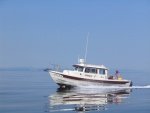hardee
New member
- Joined
- Oct 30, 2006
- Messages
- 12,637
- Reaction score
- 2
- C Dory Year
- 2005
- C Dory Model
- 22 Cruiser
- Hull Identification Number
- Brat # 2202
- Vessel Name
- Sleepy-C
Gratitude Jim,
Good story and learning experience. I would agree with the previous, (Slow down, bow up, take the wake at close to 90, and make sure the forward hatch is dogged). The speed, draft, depth, and direction (angle of turn if that is going on) all have affect on the wake the big ships put out.
In my experience, anything closer that a mile is toooo close for most wake crossings. (That is why I really like my AIS receiver - it gives me closest pint of approach and time to cpa)
About 2 years ago, I had a very strange wake crossing experience and wrote it up here
http://www.c-brats.com/viewtopic.php?t= ... light=wake
Might be of interest to you.
Over my time on the straits here, I would say the worst wakes are in this order z(wake size not frequency) from worst to better..
Submarine
Big Ocean going tugs running at speed and without a tow
Car haulers
It's probably a good idea to stand off, or run down (away) from the wake until it looks more comfortable. My preference is to be at least a mile from the ship that made the wake, and even then I will probably take it at near 90, slow, just above an idle speed so I can maintain steering, and keep a hand on the throttle.
By the way, the pictures of the C-Dory on the Columbia River bar were done for a publicity package, and they were intentionally jumping those waves. The boat was not loaded for fishing or cruising and there was a 50-60 ft vessel standing by (as the photo platform). Yes the boat will take it, but do you want to?
Enjoy,
Harvey
SleepyC:moon

Good story and learning experience. I would agree with the previous, (Slow down, bow up, take the wake at close to 90, and make sure the forward hatch is dogged). The speed, draft, depth, and direction (angle of turn if that is going on) all have affect on the wake the big ships put out.
In my experience, anything closer that a mile is toooo close for most wake crossings. (That is why I really like my AIS receiver - it gives me closest pint of approach and time to cpa)
About 2 years ago, I had a very strange wake crossing experience and wrote it up here
http://www.c-brats.com/viewtopic.php?t= ... light=wake
Might be of interest to you.
Over my time on the straits here, I would say the worst wakes are in this order z(wake size not frequency) from worst to better..
Submarine
Big Ocean going tugs running at speed and without a tow
Car haulers
It's probably a good idea to stand off, or run down (away) from the wake until it looks more comfortable. My preference is to be at least a mile from the ship that made the wake, and even then I will probably take it at near 90, slow, just above an idle speed so I can maintain steering, and keep a hand on the throttle.
By the way, the pictures of the C-Dory on the Columbia River bar were done for a publicity package, and they were intentionally jumping those waves. The boat was not loaded for fishing or cruising and there was a 50-60 ft vessel standing by (as the photo platform). Yes the boat will take it, but do you want to?
Enjoy,
Harvey
SleepyC:moon

